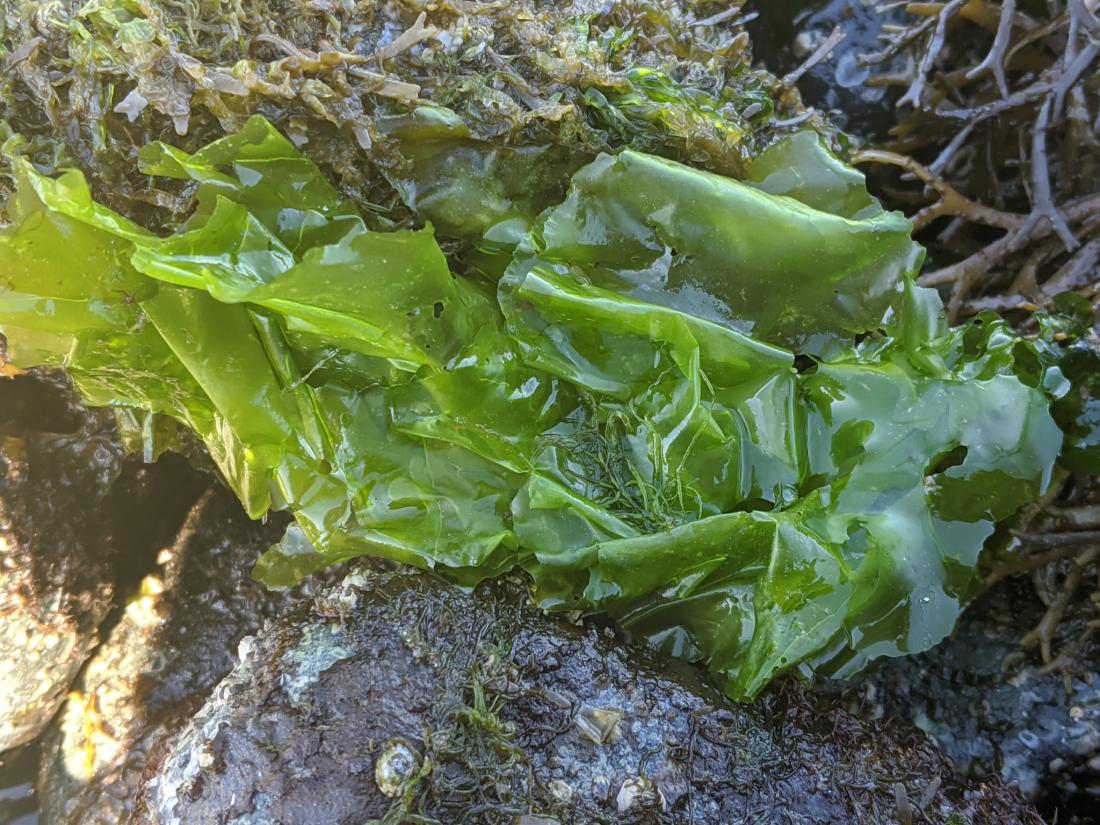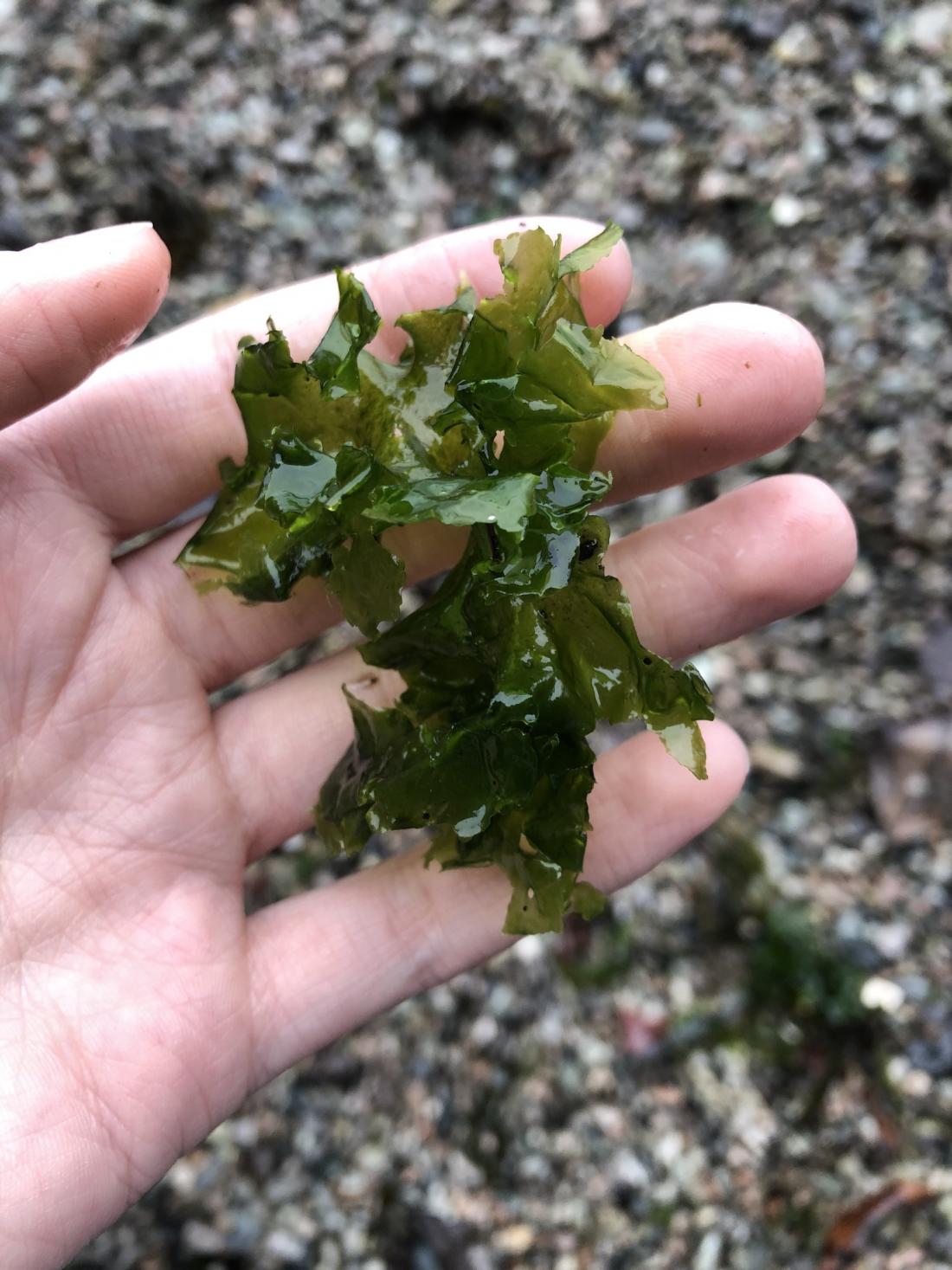Sea Lettuce
Ulva lactuca
The Science
THE SCIENCE
This lettuce is not a plant-- it is an alga with "leaves" (called thalli) that are only two cell layers thick! [10]

Taxonomic description
- Is a green alga (phylum Chlorophyta) that varies in color from pale to bright green! [1,11]
- When reproductive, the margins of the thalli appear white indicating that gametes have been released and only the cell walls remain. [10]
- Thalli are two cells thick and can grow up to 60 cm long although 30 cm is more common. [10]
- Holdfasts are small and inconspicuous. [10]
Distribution
- Found around the world, including Europe, North American coasts, Central America, Caribbean Islands, South America, Indian Oceanic islands, Southwest Asia, Pacific Islands, Australia, and New Zealand. [10, 11]
- Found throughout the entire coastline of California. [14]
Life history
- Can reproduce asexually, where fragments of sea lettuce can turn into new individuals. [12, 13]
- Undergoes alternation of generations, where it has distinct sexual and asexual reproductive stages by producing haploid thalli and diploid thalli at different times. [13]
Habitat
- Grows in protected and semi-protected intertidal and shallow subtidal areas attached to hard substrate (rocks) or seagrass, and can be found floating mid-tide. [10]
- Very opportunistic, and will grow very quickly in areas with lots of nutrients. [10]
The Fishery
THE FISHERY
Aquaculture of sea lettuce is currently being explored in California! [15]

Seasonal availability
- Available year-round for foraging. [14]
- In California, there is limited availability for farmed sea lettuce. [15]
Regulatory and managing authority
- Marine aquaculture in California is overseen by a number of federal and state agencies the specifics of which depend upon the location of the facility (land, state waters, federal waters) and type(s) of species grown. These agencies include but are not limited to NOAA, for oversight in federal waters, California State Lands Commission, for oversight in coastal waters and land, and California Department of Fish and Wildlife for registration. [16,17]
- A State Aquaculture Coordinator provides guidance on permits, registrations, and consultations, which are required for all commercial aquaculture. [17]
- The California Department of Public Health is involved in growing, harvesting, and selling molluscan shellfish and seaweeds. [17]
- On public and private lands, aquaculture must follow regulations regarding water discharge, which involves multiple management agencies. [17]
- The Permit Guide to Aquaculture in California is available at California Aquaculture. [17]
Gear type
- Seaweed farms are currently exploring the use of indoor aquaculture strategies, or grow sea lettuce on the shore using a regenerative ocean farming model. [18,19]
Status of fishery
- Not under threat of decline. [10]
Potential ecosystem impacts
- Sea lettuce absorbs excessive nutrients in the water, and is being explored as a potential bio-filter for aquaculture waste. [5]
- Sea lettuce also has potential to be used in mitigating the effects of climate change. [4]
- An extreme overabundance of sea lettuce may lead to fumes from rotting algae that can be potentially deadly, although this is rare. [20]
The Seafood
THE SEAFOOD
Sea lettuce is extremely versatile and is used as everything from a seasoning to being a main dish. [21, 22]


Edible portions
- The entire sea lettuce is edible! [21]
Culinary uses
- Sea lettuce has many culinary uses; can be used as a garnish, dried, powdered, served raw, and in soups. [21]
Description of seaweed
- Light and flakey when dried, and has a smooth and slimy texture when hydrated. [22]
Nutritional information
- Sea lettuce is very healthy--contains more calcium than whole milk, and is a good source of fiber, amino acids, vitamins, and minerals. [3, 7, 8, 9]
- Nutritional information is available on the table to the right. [6]
Toxicity report
- Because it grows wherever nutrients are available, wild sea lettuce can grow in polluted areas not suitable for human consumption. [21, 22]
- Can accumulate heavy metals and other pollutants, as it may readily absorb things from its surroundings. [1]
- Farmed sea lettuce is grown under strict food safety regulations and is safe to eat while wild sea lettuce is not tested, so foraging should be done with care.
Seasonal availability
- Year-round depending on location and method of obtaining [14,15]
References
[1] Bordean, D., Borozan, A. B., Cojocariu, L., Horablaga, A., & C Bostan. Proquest. 2016. Ulva Lactuca Consumption: A "healthy Risk"?. Web. https://search.proquest.com/docview/2014892747?accountid=14524.
[2] Fleurence, J. ScienceDirect. 1999. Seaweed proteins: biochemical, nutritional aspects and potential uses. Web. https://doi.org/10.1016/S0924-2244(99)00015-1.
[3] Misurcova, L. ResearchGate. 2011. Chemical Composition of Seaweeds. Web. https://www.researchgate.net/publication/277698824_Chemical_Composition….
[4] Duarte, C. M., Losada, I. J., Hendriks, I. E., Mazarrasa, I., & N Marbà. Nature. 2013. The role of coastal plant communities for climate change mitigation and adaptation. Web. https://www.nature.com/articles/nclimate1970.
[5] Shpigel, M., Guttman, L., Ben-Ezra, D., Yu, J., & Chen, S. (2019). Is ulva sp. able to be an efficient biofilter for mariculture effluents? Journal of Applied Phycology, 31(4), 1-11. doi:http://dx.doi.org/10.1007/s10811-019-1748-7
[6] Sea Lettuce (Green Laver/Aosa). n.d. Calorie Slism. Web. https://slism.com/calorie/109001/#foodDataDetail. Accessed 5 July 2020.
[7] MacArtain, P., Gill, C. I., Brooks, M., Campbell, R. and I. R Rowland. Oxford Academic. 2007. Nutritional Value of Edible Seaweeds. Web. https://doi.org/10.1111/j.1753-4887.2007.tb00278.x.
[8] Déléris, P., Nazih, H., & J. M. Bard. 2016. Seaweeds in Human Health. Pages 319-367 in J. Fleurence & I. Levine, editors. Seaweed in Health and Disease Prevention. Academic Press
[9] Ortiz, J., Romero, N., Robert, P., Araya, J., Lopez-Hernández, J., Bozzo, C., Osorio, A., A. Rios. Elsevier. 2006. Dietary fiber, amino acid, fatty acid and tocopherol contents of the edible seaweeds Ulva lactuca and Durvillaea antarctica. Web. https://doi.org/10.1016/j.foodchem.2005.07.027.
[10] Biodiversity of the Central Coast. Sea lettuce, Ulva lactuca.Web. centralcoastbiodiversity.org/sea-lettuce-bull-ulva-lactuca.html. Accessed 05 July 2020.
[11] World Register of Marine Species. Ulva lactuca.Web. http://www.marinespecies.org/aphia.php?p=taxdetails&id=145984#images. Accessed 29 June 2020.
[12] Bonneau, E.R. 1978. Asexual Reproductive Capabilities in Ulva lactuca L. (Chlorophyceae). Botanica Marina 21(2), 117-121. https://doi.org/10.1515/botm.1978.21.2.117
[13] Mehak, N. n.d. Classification of Ulvales. Web. https://www.biologydiscussion.com/algae/classification-of-ulvales-algae…. Accesed 06 July 2020.
[14] California Department of Fish and Wildlife. 2020. Commonly Harvested Kelp and Other Marine Algae. Web. https://wildlife.ca.gov/Conservation/Marine/Kelp/Commonly-harvested-mar…. Accessed 30 June 2020.
[15] Monterey Bay Seaweeds. 2020. Seaweed Knowledge. Web. http://www.montereybayseaweeds.com/about-seaweed. Accessed 30 June 2020.
[16] California Department of Fish and Wildlife. 2020. Recreational Harvest of Kelp and Other Marine Algae. Web. https://wildlife.ca.gov/Conservation/Marine/Kelp/Recreational-Harvest. Accessed 30 June 2020.
[17] Permit Guide to Aquaculture in California. N.d. Permit Guide to Aquaculture in California. Web. https://permits.aquaculturematters.ca.gov/Permit-Guide#454735-californi…. Accessed 21 August 2020.
[18] Mendoza, W., Mendoloa, D., Kim, J., Yarish, C., Velloze, A., Mitchell, B.G. Global Aquaculture Alliance. 2019. Land-based drip-irrigated culture of sea lettuce. Web. https://www.aquaculturealliance.org/advocate/land-based-drip-irrigated-… Accessed 30 June 2020.
[19] Sunken Seaweed. n.d. Seaweed Pilot Farm in San Diego Bay. Web. https://www.sunkenseaweed.com/projects. Accessed 30 June 2020.
[20] Morris, S. The Guardian. 2017. Jersey monitors threat from toxic sea lettuce fumes. Web. https://www.theguardian.com/uk-news/2017/jan/16/jersey-monitors-threat-…. Accessed 30 June 2020.
[21] Bradley, K. Milkwood. 2018. Foraging+Eating Sea Lettuce: Ulva Lactuca. Web. https://www.milkwood.net/2016/08/08/seaside-sandwich-foraging-eating-se…. Accessed 30 June 2020.
[22] Deane. Eat the Weeds. 2018. Sea Lettuce, Ulva. Web. http://www.eattheweeds.com/ulva-sea-soup-salad-2/. Accessed 30 June 2020.
[23] Peters, K. Wikipedia. 2006. Sea lettuce (Ulva lactuca). Digital image. Web. https://hu.wikipedia.org/wiki/Ulva#/media/F%C3%A1jl:Ulva_lactuca.jpeg. Accessed 24 February 2021.
[24] e_moses. iNaturalist. 2020. Digital image. Web. https://www.inaturalist.org/photos/90803153. Accessed 24 February 2021.
[25] acoulthard. iNaturalist. 2020. Digital image. Web. https://www.inaturalist.org/photos/59945065. Accessed 24 February 2021.
[26] pelican. flickr. 2012. Dumplings with sea lettuce. Digital image. Web. https://flickr.com/photos/pelican/7770042204. Accessed 24 February 2021.



